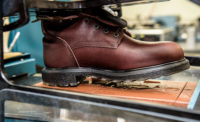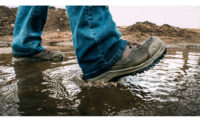Slip sliding away: A guide to slip resistance in safety footwear

Protective footwear used by employees can play a big role in preventing costly and dangerous slips, trips and falls. But not all footwear protects wearers equally. Make sure your workers wear the proper protective boots for their unique environment.
Trade-offs
Here’s how to make a solid assessment of slip resistance for your employee’s footwear:
Safety vs. cost: It’s unlikely the least expensive safety footwear will meet the slip-resistance requirements of the job. Slip-resistance comes down to the integration of several anti-slip features, all of which may affect purchase price. Shortcuts, sloppy manufacturing techniques or low-quality materials could compromise any of these features and create durability issues.
Safety vs. comfort: Safety features must exist in proper balance with comfort. If safety footwear does not fit properly or is uncomfortable, employees may not wear them consistently or find excuses to avoid wearing them.
Safety vs. overdesign: Safety footwear can be too slip-resistant for the job. Footwear that sticks to the work surface can cause injuries similar to athletes who hurt their knees when their cleats stick in the turf.
Guidelines
There are some general guidelines to consider when selecting the right slip-resistance features.
Outsole: Soft rubber compounds offer the greatest slip resistance for environments contaminated with oil and grease. Keep in mind that small changes in the compound can result in large variations in overall slip resistance.
Tread: Look for outsoles that channel oil and grease away so the outsole can reach the work surface more fully, as well as outsoles with split and solid lugs specifically designed to shed debris. Treads should allow a maximum amount of material to grip the floor. Softer soles and more tightly spaced treads are better suited to fluid contaminants in indoor environments. More widely spaced treads are generally better for handling solid contaminants in outdoor areas. Avoid clogging the tread. A wider or deeper tread pattern may be necessary if footwear needs to be cleaned often. Over time, watch for worn or flattened soles.
Insoles: Insoles do not play a direct role in slip resistance, but they should offer additional cushioning and impact padding for employees who are on their feet for extended periods or work on hard surfaces.
Upper: Uppers can be made of a long list of materials, including various leathers, suede, mesh and combinations of these. Like the insole, the upper does not directly determine slip resistance but plays a key role in fit and comfort.
Midsole: Midsole technologies do not have a direct bearing on slip resistance but are important for the overall structural integrity of footwear and the amount of comfort employees can expect throughout the day.
Durability: Employers should prioritize highly durable footwear that provides the most slip resistance for the longest period of time so the workforce can operate with confidence.
Standards for a slippery issue
Slip resistance requirements for footwear do not exist as they do for other protective aspects of safety footwear, such as toe protection or puncture resistance. A slip resistance method employers may be familiar with is the American Society of Testing Materials (ASTM) test ASTM F-1677, known as the “Mark II test.” However, the Mark II test was withdrawn by ASTM in 2006.
The new testing standard set forth by ASTM that employers should look for or ask their safety footwear provider about is ASTM F-2913 – “Standard Test Method for Measuring the Coefficient of Friction for Evaluation of Slip Performance of Footwear and Test Surfaces / Flooring Using a Whole Shoe Tester” – or “Whole Shoe test.”
In the Whole Shoe test, the footwear sole and underfoot surface are brought into contact, subjected to a specified vertical force for a short period of static contact and then moved horizontally relative to one another at a constant speed. The horizontal frictional force is measured after movement starts and the dynamic coefficient of friction is calculated.
Surface contaminants include, but are not limited to, water, ice, oil, grease and other chemicals. These contaminants are among the most prevalent, but employers have no real way of knowing how slip resistance changes if the contaminant is food, gravel, cleanser, mud or construction material.
The Whole Shoe test does not account for the risk of tripping due to footwear/ground interlock. This refers to special-purpose footwear with spikes or metal studs. A variety of other factors may affect the risk of slipping, including ambient temperature, lighting, surface irregularities, stairs and handrails, floor mats and runners, and human factors such as age, overall health, inattentive behavior, taking shortcuts or carrying objects that obstruct your view.
It’s possible to measure the coefficient of friction of a shoe, but slipping involves other variables. For example, one shoe may provide adequate slip resistance on dry concrete but becomes slippery on wet steel. Another might offer substantial slip resistance initially, but if the sole is not durable and wears down quickly, the slip resistance may also diminish.
Setting the standard
Any safety footwear provided can claim its products are slip resistant, precisely because there is no uniform global standard or rating for slip resistance. We recommends three simple principles for evaluating slip resistance:
Follow the ASTM standard test method: ASTM F-2913 or the Whole Shoe test provides the most complete approach to evaluating how different footwear materials interact with various work surfaces. All slip-resistant footwear should be tested to this standard to establish a common basis for comparison.
Understand the details: Whether or not a specific shoe or boot will provide adequate, long-term slip resistance requires an understanding of what the job actually involves: the surfaces, contaminants and physical requirements of the role. Look for a provider with experience developing purpose-built safety footwear worn in a variety of industries.
Share knowledge: Ensuring slip resistance depends on a strong, open and transparent collaboration between employer and safety footwear provider. The footwear manufacturer should provide detailed information about its products and their performance, while understanding the work environment they are best suited for.
Looking for a reprint of this article?
From high-res PDFs to custom plaques, order your copy today!





